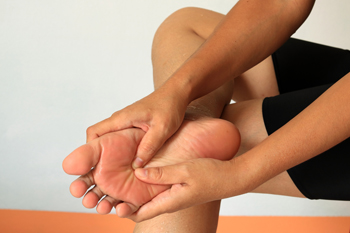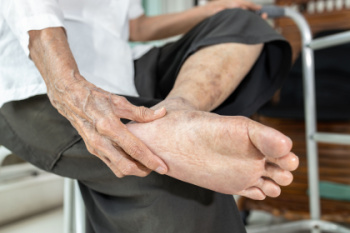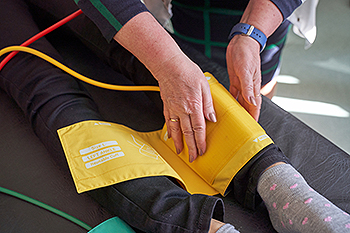Items filtered by date: April 2024
Understanding Peripheral Neuropathy and How to Manage It

Peripheral neuropathy presents a diverse range of conditions that affect peripheral nerves in the lower extremities, resulting in symptoms like numbness and weakness. Causes can include diabetes, infections, injuries, or toxin exposure, with certain individuals at a higher risk due to genetics or lifestyle factors. Diagnosis involves a thorough assessment of symptoms and medical history, often supplemented by nerve conduction studies or imaging tests. Treatment focuses on symptom management and addressing underlying causes, taking certain medications, and making lifestyle adjustments, However, outcomes vary depending on the specific condition and its severity. If you suffer from peripheral neuropathy, it is suggested that you consult a podiatrist for an accurate diagnosis and personalized treatment plan.
Neuropathy
Neuropathy can be a potentially serious condition, especially if it is left undiagnosed. If you have any concerns that you may be experiencing nerve loss in your feet, consult with one of our podiatrists from Podiatry Services . Our doctors will assess your condition and provide you with quality foot and ankle treatment for neuropathy.
What Is Neuropathy?
Neuropathy is a condition that leads to damage to the nerves in the body. Peripheral neuropathy, or neuropathy that affects your peripheral nervous system, usually occurs in the feet. Neuropathy can be triggered by a number of different causes. Such causes include diabetes, infections, cancers, disorders, and toxic substances.
Symptoms of Neuropathy Include:
- Numbness
- Sensation loss
- Prickling and tingling sensations
- Throbbing, freezing, burning pains
- Muscle weakness
Those with diabetes are at serious risk due to being unable to feel an ulcer on their feet. Diabetics usually also suffer from poor blood circulation. This can lead to the wound not healing, infections occurring, and the limb may have to be amputated.
Treatment
To treat neuropathy in the foot, podiatrists will first diagnose the cause of the neuropathy. Figuring out the underlying cause of the neuropathy will allow the podiatrist to prescribe the best treatment, whether it be caused by diabetes, toxic substance exposure, infection, etc. If the nerve has not died, then it’s possible that sensation may be able to return to the foot.
Pain medication may be issued for pain. Electrical nerve stimulation can be used to stimulate nerves. If the neuropathy is caused from pressure on the nerves, then surgery may be necessary.
If you have any questions, please feel free to contact our office located in Murrieta, CA . We offer the newest diagnostic and treatment technologies for all your foot care needs.
Tackling Tarsal Tunnel Syndrome

Tarsal tunnel syndrome is a condition characterized by compression of the tibial nerve as it passes through the tarsal tunnel, a narrow space on the inside of the ankle. It typically affects individuals who engage in activities that involve repetitive ankle motion or those with foot deformities such as flat feet. Symptoms may include pain, burning, tingling, or numbness along the inner ankle and the sole of the foot. Left untreated, tarsal tunnel syndrome can lead to complications like muscle weakness or atrophy in the foot. Management often involves conservative measures such as rest, orthotic devices, and anti-inflammatory medications to alleviate symptoms and reduce nerve compression. If you have ankle pain, it is suggested that you schedule an appointment with a podiatrist who can diagnose tarsal tunnel syndrome and provide appropriate treatment.
Tarsal tunnel syndrome can be very uncomfortable to live with. If you are experiencing tarsal tunnel syndrome, contact one of our podiatrists of Podiatry Services . Our doctors can provide the care you need to keep you pain-free and on your feet.
Tarsal Tunnel Syndrome
Tarsal tunnel syndrome, which can also be called tibial nerve dysfunction, is an uncommon condition of misfiring peripheral nerves in the foot. The tibial nerve is the peripheral nerve in the leg responsible for sensation and movement of the foot and calf muscles. In tarsal tunnel syndrome, the tibial nerve is damaged, causing problems with movement and feeling in the foot of the affected leg.
Common Cause of Tarsal Tunnel Syndrome
- Involves pressure or an injury, direct pressure on the tibial nerve for an extended period of time, sometimes caused by other body structures close by or near the knee.
- Diseases that damage nerves, including diabetes, may cause tarsal tunnel syndrome.
- At times, tarsal tunnel syndrome can appear without an obvious cause in some cases.
The Effects of Tarsal Tunnel Syndrome
- Different sensations, an afflicted person may experience pain, tingling, burning or other unusual sensations in the foot of the affected leg.
- The foot muscles, toes and ankle become weaker, and curling your toes or flexing your foot can become difficult.
- If condition worsens, infections and ulcers may develop on the foot that is experiencing the syndrome.
A physical exam of the leg can help identify the presence of tarsal tunnel syndrome. Medical tests, such as a nerve biopsy, are also used to diagnose the condition. Patients may receive physical therapy and prescriptive medication. In extreme cases, some may require surgery.
If you have any questions please feel free to contact our office located in Murrieta, CA . We offer the newest diagnostic and treatment technologies for all your foot and ankle needs.
Symptoms of Peripheral Artery Disease
 Peripheral artery disease, or PAD, is a condition where the arteries that supply blood to the legs and feet become narrowed or blocked due to plaque buildup. This decreases blood flow to the lower extremities. Symptoms of PAD can vary but often include leg pain or cramping while walking or climbing stairs, which typically eases with rest. Some people may also experience numbness, weakness, or a cold sensation in their lower legs or feet. Changes in the color of the skin or slower growth of the nails may also occur. In more severe cases, PAD can lead to wounds or ulcers on the feet or legs that heal poorly or not at all. Getting diagnosed early is important because PAD can be a sign of more widespread arterial disease, which could increase the risk of heart attack or stroke. Early treatment can help manage symptoms, improve mobility, and reduce the risk of more serious complications. It is suggested that you consult a podiatrist, or foot doctor, for help if you are experiencing any symptoms that sound like PAD.
Peripheral artery disease, or PAD, is a condition where the arteries that supply blood to the legs and feet become narrowed or blocked due to plaque buildup. This decreases blood flow to the lower extremities. Symptoms of PAD can vary but often include leg pain or cramping while walking or climbing stairs, which typically eases with rest. Some people may also experience numbness, weakness, or a cold sensation in their lower legs or feet. Changes in the color of the skin or slower growth of the nails may also occur. In more severe cases, PAD can lead to wounds or ulcers on the feet or legs that heal poorly or not at all. Getting diagnosed early is important because PAD can be a sign of more widespread arterial disease, which could increase the risk of heart attack or stroke. Early treatment can help manage symptoms, improve mobility, and reduce the risk of more serious complications. It is suggested that you consult a podiatrist, or foot doctor, for help if you are experiencing any symptoms that sound like PAD.
Peripheral artery disease can pose a serious risk to your health. It can increase the risk of stroke and heart attack. If you have symptoms of peripheral artery disease, consult with one of our podiatrists from Podiatry Services . Our doctors will assess your condition and provide you with quality foot and ankle treatment.
Peripheral artery disease (PAD) is when arteries are constricted due to plaque (fatty deposits) build-up. This results in less blood flow to the legs and other extremities. The main cause of PAD is atherosclerosis, in which plaque builds up in the arteries.
Symptoms
Symptoms of PAD include:
- Claudication (leg pain from walking)
- Numbness in legs
- Decrease in growth of leg hair and toenails
- Paleness of the skin
- Erectile dysfunction
- Sores and wounds on legs and feet that won’t heal
- Coldness in one leg
It is important to note that a majority of individuals never show any symptoms of PAD.
Diagnosis
While PAD occurs in the legs and arteries, Podiatrists can diagnose PAD. Podiatrists utilize a test called an ankle-brachial index (ABI). An ABI test compares blood pressure in your arm to you ankle to see if any abnormality occurs. Ultrasound and imaging devices may also be used.
Treatment
Fortunately, lifestyle changes such as maintaining a healthy diet, exercising, managing cholesterol and blood sugar levels, and quitting smoking, can all treat PAD. Medications that prevent clots from occurring can be prescribed. Finally, in some cases, surgery may be recommended.
If you have any questions, please feel free to contact our office located in Murrieta, CA . We offer the newest diagnostic and treatment technologies for all your foot care needs.
The Importance of Proper Shoe Fit to Prevent Heel Pain

Ensuring proper shoe fit goes a long way in preventing heel pain, where both support and comfort play pivotal roles. Wearing ill-fitting shoes, particularly high heels, and narrow styles, exacerbate heel discomfort by placing excessive pressure on the heel and altering natural foot mechanics. During the pandemic, the widespread adoption of unsupportive footwear like slippers and flip-flops further contributed to foot problems, as they lacked adequate arch support and cushioning. As individuals age, foot structures change, making them more susceptible to heel pain. Therefore, it is imperative to prioritize footwear that offers ample support and cushioning to alleviate strain on the heels and promote proper alignment. Opting for shoes with a wide-toe box, cushioned insoles, and low to moderate heels can help distribute weight evenly and reduce heel pain. If you suffer from persistent heel pain, it is strongly suggested that you schedule an appointment with a podiatrist who can diagnose the cause and offer guidance on the best shoes to wear for your particular needs and circumstances.
Many people suffer from bouts of heel pain. For more information, contact one of our podiatrists of Podiatry Services . Our doctors can provide the care you need to keep you pain-free and on your feet.
Causes of Heel Pain
Heel pain is often associated with plantar fasciitis. The plantar fascia is a band of tissues that extends along the bottom of the foot. A rip or tear in this ligament can cause inflammation of the tissue.
Achilles tendonitis is another cause of heel pain. Inflammation of the Achilles tendon will cause pain from fractures and muscle tearing. Lack of flexibility is also another symptom.
Heel spurs are another cause of pain. When the tissues of the plantar fascia undergo a great deal of stress, it can lead to ligament separation from the heel bone, causing heel spurs.
Why Might Heel Pain Occur?
- Wearing ill-fitting shoes
- Wearing non-supportive shoes
- Weight change
- Excessive running
Treatments
Heel pain should be treated as soon as possible for immediate results. Keeping your feet in a stress-free environment will help. If you suffer from Achilles tendonitis or plantar fasciitis, applying ice will reduce the swelling. Stretching before an exercise like running will help the muscles. Using all these tips will help make heel pain a condition of the past.
If you have any questions please contact our office located in Murrieta, CA . We offer the newest diagnostic and treatment technologies for all your foot and ankle needs.
Keep Your Feet Healthy So You Can Stay Active
Foot Corns

Corns on the feet, medically termed keratotic lesions, are areas of thickened skin caused by repeated friction or pressure. They commonly occur on weight-bearing areas like the toes and soles of the feet. Symptoms can include localized pain or tenderness, a hardened or raised bump, and sometimes inflammation or redness. Older individuals are more prone to developing corns due to factors like reduced skin elasticity and altered foot mechanics. There are three main types of corns. Hard corns are small, dense, and are usually found on bony areas. Soft corns are moist and typically form between toes where the skin is moist. Seed corns are tiny and appear on non-weight-bearing areas. Diagnosis is typically made based on clinical examination. Management involves relieving pressure on the affected area, wearing properly fitting footwear, using protective pads or cushions, and sometimes, having the corn removed. If you have persistent or painful corns, it is suggested that you schedule an appointment with a podiatrist for treatment.
Corns can make walking very painful and should be treated immediately. If you have questions regarding your feet and ankles, contact one of our podiatrists of Podiatry Services . Our doctors will treat your foot and ankle needs.
Corns: What Are They? And How Do You Get Rid of Them?
Corns are thickened areas on the skin that can become painful. They are caused by excessive pressure and friction on the skin. Corns press into the deeper layers of the skin and are usually round in shape.
Ways to Prevent Corns
There are many ways to get rid of painful corns such as:
- Wearing properly fitting shoes that have been measured by a professional
- Wearing shoes that are not sharply pointed or have high heels
- Wearing only shoes that offer support
Treating Corns
Although most corns slowly disappear when the friction or pressure stops, this isn’t always the case. Consult with your podiatrist to determine the best treatment option for your case of corns.
If you have any questions please feel free to contact our office located in Murrieta, CA . We offer the newest diagnostic and treatment technologies for all your foot and ankle needs.

